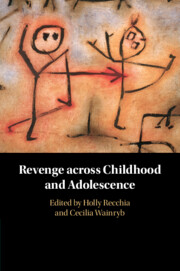Book contents
- Revenge across Childhood and Adolescence
- Revenge across Childhood and Adolescence
- Copyright page
- Dedication
- Contents
- Figures
- Tables
- Contributors
- Acknowledgments
- Chapter 1 And If You Wrong Us, Shall We Not Revenge?
- Chapter 2 A Framework for Understanding Variation in Youth Revenge Motivations and Retaliatory Behaviors
- Chapter 3 Normative Changes and Individual Differences in Retaliation Judgments
- Chapter 4 Developing Revenge in Early Childhood
- Chapter 5 Understanding Youths’ Retaliatory Experiences through the Lens of Moral Agency
- Chapter 6 Cultural Systems and the Development of Norms Governing Revenge and Retribution
- Chapter 7 Settling the Score in a Zero-Sum Game
- Chapter 8 Intergroup Processes
- Chapter 9 Revenge, Justice Systems, and Institutional Trust in Schools
- Chapter 10 The Importance of a Positive School Climate in Addressing Youth Retaliation
- Chapter 11 Socioemotional Competencies and Positive Classroom Climate as Alternatives to Prevent Revenge in Colombian Schools
- Chapter 12 Looking Back and Charting a Course
- Index
- References
Chapter 7 - Settling the Score in a Zero-Sum Game
Understanding Revenge among Urban Male Youth Overexposed to Gun Violence
Published online by Cambridge University Press: 08 July 2021
- Revenge across Childhood and Adolescence
- Revenge across Childhood and Adolescence
- Copyright page
- Dedication
- Contents
- Figures
- Tables
- Contributors
- Acknowledgments
- Chapter 1 And If You Wrong Us, Shall We Not Revenge?
- Chapter 2 A Framework for Understanding Variation in Youth Revenge Motivations and Retaliatory Behaviors
- Chapter 3 Normative Changes and Individual Differences in Retaliation Judgments
- Chapter 4 Developing Revenge in Early Childhood
- Chapter 5 Understanding Youths’ Retaliatory Experiences through the Lens of Moral Agency
- Chapter 6 Cultural Systems and the Development of Norms Governing Revenge and Retribution
- Chapter 7 Settling the Score in a Zero-Sum Game
- Chapter 8 Intergroup Processes
- Chapter 9 Revenge, Justice Systems, and Institutional Trust in Schools
- Chapter 10 The Importance of a Positive School Climate in Addressing Youth Retaliation
- Chapter 11 Socioemotional Competencies and Positive Classroom Climate as Alternatives to Prevent Revenge in Colombian Schools
- Chapter 12 Looking Back and Charting a Course
- Index
- References
Summary
Adolescent development is strained by exposure to community violence, especially when shootings and killings happen in public spaces such as the street or popular locations where young people hangout. This chapter examines revenge violence from a situational-transactional framework by focusing on accounts of marginalized urban youth overly exposed to gun violence. Revenge-sparked events are linked to a prior negative interaction. The aftermath of the prior incident can proceed in somewhat predictable ways with participants assessing damage, stewing about the conflict, planning revenge, casting co-offenders, brewing on the issue until the right opportunity comes up, and initiating the revenge incident. Four main themes emerge to illustrate how scripts favorable to seeking revenge or anticipating revenge are internalized by young men living in unsafe urban neighborhoods. Insights about the transactional dynamic of retaliatory violence should be used in formulating holistic community-based solutions, individual-level outreach interventions, and practitioner efforts to reduce urban violence.
Keywords
- Type
- Chapter
- Information
- Revenge across Childhood and Adolescence , pp. 161 - 186Publisher: Cambridge University PressPrint publication year: 2021



